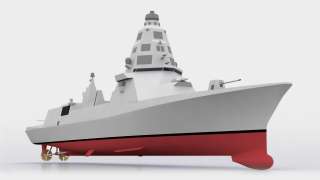Çafrad
Description of the radar set, tactical-technical characteristics

Figure 1: Çafrad
| Specifications | UMR | ÇFR |
|---|---|---|
| frequency: | S-Band | X-Band |
| pulse repetition time (PRT): | ||
| pulse repetition frequency (PRF): | ||
| pulsewidth (τ): | ||
| receive time: | ||
| dead time: | ||
| peak power: | ||
| average power: | ||
| instrumented range: | 450 km | 150 km |
| range resolution: | ||
| accuracy: | ||
| beamwidth: | ||
| hits per scan: | ||
| antenna rotation: | ||
| MTBCF: | ||
| MTTR: | ||
Çafrad
The Çafrad Radar System (Çok Amaçlı Faz Dizinli Radar, “Multifunctional Phased Array Radar”) was developed by the Turkish manufacturer Aselsan for the Turkish Navy and uses active phased array antennas with a total of 10 000 transmitting/receiving modules in Gallium Nitride technology. It consists of an S-Band multifunctional radar (UMR) for airspace and naval reconnaissance, an X-Band multifunctional target tracking radar (ÇFR) and an X-Band continuous wave target illumination radar (AYR) for a semi-active missile control system. Each radar uses four antenna surfaces, each covering 90° azimuth angles.
The project planning of the system began approximately in the years 2013 to 2014 and was already completed at the trade fair of the Turkish defence industry IDEF 2015 to the public as a project. Since the beginning of 2016, the project has been in the phase of parallel system development and production. A version mounted on a truck can also be used for an extensive land-based air defense system. This land-based version has already been presented and tested as a prototype. The naval version was successfully (with each one antenna face) tested under marine conditions on the frigate F 497 (G- Class or Gabya- Class). under maritime conditions and is to go into series production until 2021.
Source:
- Manufacturers Leaflet
